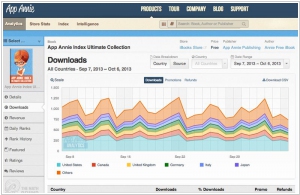Google Analytics vs data.ai
July 25, 2023 | Author: Michael Stromann
40
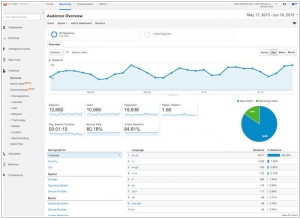
Google Analytics lets you measure your advertising ROI as well as track your Flash, video, and social networking sites and applications. Google Analytics shows you the full customer picture across ads and videos, websites and social tools, tablets and smartphones. That makes it easier to serve your current customers and win new ones.
Google Analytics and data.ai are both analytics platforms, but they serve different purposes and offer distinct features. Google Analytics is a widely-used web analytics tool provided by Google, primarily focused on tracking and analyzing website and app traffic. It provides valuable insights into user behavior, demographics, and interactions on the website, helping businesses optimize their online presence and marketing efforts. On the other hand, data.ai is an AI-driven analytics platform that specializes in advanced data analysis, machine learning, and predictive modeling. It is designed to handle large and complex datasets, allowing businesses to uncover deeper insights, trends, and patterns in their data to make data-driven decisions. While Google Analytics is more suitable for website and app analytics, data.ai caters to organizations seeking sophisticated data analysis and AI-powered insights to drive strategic decision-making across various industries.
See also: Top 10 Mobile App Analytics platforms
See also: Top 10 Mobile App Analytics platforms
Google Analytics vs data.ai in our news:
2020. Google Analytics 4 allows to combine website and mobile app statistics
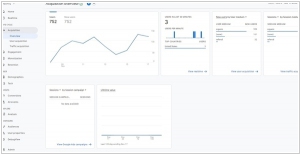
Google has introduced a major update to its website analytics platform, Google Analytics 4. The key highlight of this update is the inclusion of a new resource type called App + Web. This feature allows users to combine data from both websites and mobile applications, enabling the creation of unified reports for comprehensive analysis. The functionality of analytics tools has been significantly revamped, with improved visualization of user behavior and the adoption of a new model called "Event + Parameter." Notably, the updated platform now offers enhanced capabilities for online stores. Users can create user groups based on the likelihood of placing an order or leaving the website within the next seven days. It is important to note that the option to continue using the previous version, Universal Analytics (UA), is still available. Users have the flexibility to work with both Universal Analytics and Google Analytics 4 simultaneously by creating new resources with dual analytics capabilities (UA + GA4). This dual approach is designed to accommodate users who may find exclusive use of the new tool less convenient in certain scenarios.
2016. Google Analytics adds automated insights
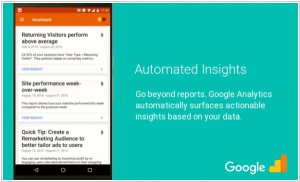
Google Analytics has introduced enhanced functionality on iOS and Android platforms, allowing users to easily identify crucial trends within their data. On the Assistant screen, users will now have access to automatically generated insights. For instance, if there is a sudden surge in new users on your website or app, Google Analytics will prominently highlight this information and provide details regarding the source of these new users. Likewise, for e-commerce companies, it can pinpoint the products experiencing the most significant increase in sales. Although Google Analytics was already tracking this information, it is now presented in a concise and easily digestible card format. This enhancement enables businesses to swiftly access the relevant information without the need to navigate through multiple pages, reducing the chances of overlooking important data changes.
2016. New Google Analytics app improves user experience
The most recent update of the Google Analytics app (version 3.0) introduces several features inspired by chat platforms. Google has streamlined the app's navigation, resulting in a cleaner interface that enhances the visibility of reports. Metrics and dimensions are now displayed within scorecards, which bear a resemblance to the widgets found in Google Analytics dashboards. These scorecards present a concise overview of the top dimensions within a specific report. By utilizing familiar tablet and smartphone user behaviors, such as swiping, users can easily navigate to their desired dimensions. The condensed listing of scorecards also facilitates the effortless discovery and bookmarking of reports.
2016. Mobile analytics service App Annie raised $63 Million
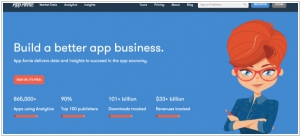
App Annie, a platform that assists developers, investors, and journalists in gaining deeper insights into app rankings and trends, has successfully secured $63 million in Series E funding. This financing round takes place approximately one year after App Annie raised $55 million, bringing the total funding for the company to approximately $157 million. The infusion of new capital aims to further accelerate the company's already rapid growth. Currently, App Annie boasts 500,000 registered members, with "hundreds" of them subscribing annually for access to its advanced analytics services. The average yearly subscription costs $80,000 per subscriber.
2015. Google Analytics adds Calculated Metrics
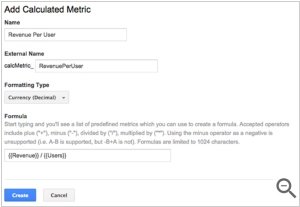
Google has introduced a new feature in Google Analytics called Calculated Metrics. This feature enables users to create custom metrics based on existing metrics within Google Analytics. It eliminates the need to navigate away from the report, streamlining the process of performing calculations. Essentially, Calculated Metrics serves as a convenient tool for adding compound metrics that frequently arise in business intelligence discussions. For instance, an e-commerce retailer could generate a currency conversion metric by multiplying the Revenue metric from Google Analytics reports with the current conversion rate. To access Calculated Metrics, users can find it in the admin panel under the view column.
2015. Mobile analitycs service App Annie integrates with Google Analytics
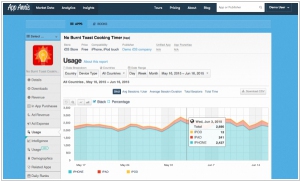
The mobile app intelligence platform App Annie has expanded its range of features by introducing in-app analytics. This new service seamlessly integrates with Google Analytics, providing app developers with a convenient way to access usage metrics from five app stores, in addition to data from 34 advertising platforms, all within a unified online dashboard. The supported app stores include iTunes, Google Play, the Amazon Appstore, the Windows Store, and the Windows Phone Store. Furthermore, App Annie is capable of aggregating advertising data from various services such as Tapjoy, Inmobi, Applovin, Facebook, AdMob, AppLift, and many others. Currently, the In-App Analytics feature is offered for free by App Annie. Developers can begin utilizing it without the need to install an SDK; instead, they simply add Google Analytics as a new "connection" on their dashboard.
2014. Google Analytics is available on iPhone
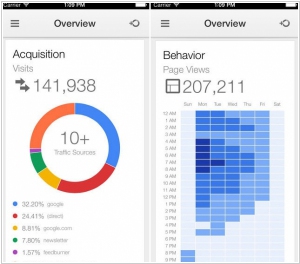
After more than two years of launching Google Analytics for Android, Google has now introduced a version of Google Analytics specifically designed for the iPhone. This app enables users to conveniently monitor their website analytics, including real-time visitor reports, directly from their smartphones. In addition to providing real-time and time-based reports, the app offers insights into user behaviors, conversions, and more. The user interface (UI) of the app aligns with the aesthetic of other Google apps available for iOS. Moreover, the app leverages the sign-in capabilities of Gmail, Google+, and the standard Google app for iOS. It's important to note that Google Analytics for iPhone is currently not optimized for iPad, but there is hope that future updates will include support for iPads.
2014. Google Analytics gets brand new E-Commerce section
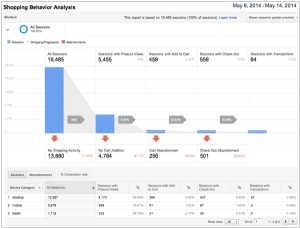
Google is introducing a comprehensive overhaul of its Google Analytics E-commerce, focusing on delivering insights throughout the entire customer journey, going beyond just the purchase stage. The updated version includes new metrics such as product detail views, 'add to cart' actions, clicks on internal campaigns, the effectiveness of internal merchandising tools, the checkout process, and the final purchase. Additionally, users can now create audience segments directly from funnel reports to analyze user actions, including cart and product page abandons. Funnels are accessible at the device category level, as depicted in the screenshot below.

